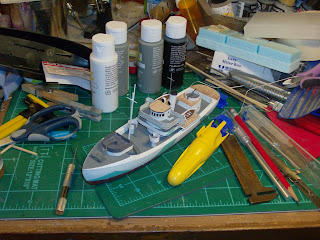 |
| A model Admiralty trawler and its means of propulsion. |
In the summer of 1976, my best friend Craig and I undertook a crash course in model ship construction. I already had some experience, as did he, but what we wanted to learn was how to build powered models, hoping to ultimately lead to radio controlled.
My first experience in building a motorized model ship resulted in a mess (more on that soon). The next attempt, with a large Lindberg Tirpitz, was a bit better. Still, we wanted to learn how to motorize smaller models.
The solution was the submarine motor.
Well, that was one name for it. We called them torpedo motors as well. These had been around since at least the 1960's, and Craig had two.
We began experimenting in earnest. We would attach the motors to the underside of the ships with rubber bands, oftentimes ignoring model details as we did so.
The models were taken to the pool at the apartment complex where he lived, where we let them run all hours of the night.
Soon, we out of AA batteries, so we resulted to using larger cells, sometimes up to D size, using a combination of stopping tape and wire to accomplish the task.
With the heavier cells, the models handled a bit poorly, but could now run longer.
Once, we got the crazy idea to assemble a series of batteries to see how much speed we could get out of one of the units. At one point, this included a crazy combination of C and D cells, four in total, 6 volts going into a motor designed for 3. We tested that combination under his USS Montrose.
There were kids in the pool, so the waves were monstrous for the small model. Still, once we twisted the two wires together, the motor kicked in, sounding like a dental drill, and the model took off like a heavily loaded speedboat.
By the end of autumn that year, the experiments stopped. I'm not sure why exactly. Perhaps it is because, now as eighth graders, we were "moving on", which for us meant model airplanes. Maybe the motors died, which was entirely possible. Whatever the reason, those experiments ended.
Now, a few decades later, I am once more playing with motorized model ships, and once more, the submarine/torpedo motor is playing a role. Today's motors are still the same basic design from my childhood, but are far sturdier. My current motor is from Tamiya, and was purchased with a small boat hull (which will soon be put to use). Tamiya isn't the only manufacturer of them today. Playmobile also makes them. Like the classic design, the run on a single AA battery and power up by twisting the forward end.
In the picture, mine is sitting in front of my latest project, a wooden model Admiralty trawler, which it is to motorize.
That's another story.
My first experience in building a motorized model ship resulted in a mess (more on that soon). The next attempt, with a large Lindberg Tirpitz, was a bit better. Still, we wanted to learn how to motorize smaller models.
The solution was the submarine motor.
Well, that was one name for it. We called them torpedo motors as well. These had been around since at least the 1960's, and Craig had two.
We began experimenting in earnest. We would attach the motors to the underside of the ships with rubber bands, oftentimes ignoring model details as we did so.
The models were taken to the pool at the apartment complex where he lived, where we let them run all hours of the night.
Soon, we out of AA batteries, so we resulted to using larger cells, sometimes up to D size, using a combination of stopping tape and wire to accomplish the task.
With the heavier cells, the models handled a bit poorly, but could now run longer.
Once, we got the crazy idea to assemble a series of batteries to see how much speed we could get out of one of the units. At one point, this included a crazy combination of C and D cells, four in total, 6 volts going into a motor designed for 3. We tested that combination under his USS Montrose.
There were kids in the pool, so the waves were monstrous for the small model. Still, once we twisted the two wires together, the motor kicked in, sounding like a dental drill, and the model took off like a heavily loaded speedboat.
By the end of autumn that year, the experiments stopped. I'm not sure why exactly. Perhaps it is because, now as eighth graders, we were "moving on", which for us meant model airplanes. Maybe the motors died, which was entirely possible. Whatever the reason, those experiments ended.
Now, a few decades later, I am once more playing with motorized model ships, and once more, the submarine/torpedo motor is playing a role. Today's motors are still the same basic design from my childhood, but are far sturdier. My current motor is from Tamiya, and was purchased with a small boat hull (which will soon be put to use). Tamiya isn't the only manufacturer of them today. Playmobile also makes them. Like the classic design, the run on a single AA battery and power up by twisting the forward end.
In the picture, mine is sitting in front of my latest project, a wooden model Admiralty trawler, which it is to motorize.
That's another story.
No comments:
Post a Comment